Brothers Stewart and Robert Kircher weren’t born into the dairy industry. Robert Kircher said he and Stewart began working summers with dairy cows as young teenagers at Forest Glen Oaks Farm in Yamhill County, about an hour southwest of Portland. Back then the farm had a few hundred cows.
There, the brothers worked their way up into management positions and grew the farm, which is now an organic milk operation with about 50 workers and more than 2,000 Jersey dairy cows between two facilities. The farm produces over 100,000 pounds of milk — nearly 12,000 gallons — a day, and supplies local processors and grocery retailers.
The brothers also grow most of the feed for their livestock across 3,000 acres of farmland. It’s a lot of work — and a hard business, financially, Kircher said.
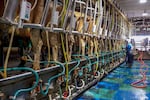
A worker milking a line of cows at Forest Glen Oaks Dairy Farm in Dayton, Ore., April 30, 2024. Robert Kircher said the farm produces over 100,000 pounds of organic milk a day.
Alejandro Figueroa / OPB
Throughout the years, Robert Kircher said, he’s seen the industry change, especially as operation costs have gone up.
“There’s demand for more milk products in the Northwest here, but we’re all kind of stuck right now because we’re price takers,” he said. “We don’t get to set the price on what we produce.”
Stewart Kircher, standing next to his brother at the farm’s milking parlor, said they also have to invest thousands of dollars and time to comply with state and federal rules. Those rules require they provide detailed plans outlining how they manage water and store and use all the manure produced by their livestock.
He pointed to the drains where all the wash water from the milking area ran.
“You can see this barn’s sloped at a peak. Everything slopes that way and everything slopes this way,” Stewart Kircher said. “Every drop of water that’s created in this parlor is captured in drains, either here or on the back side of the barn. And everything ends up on the lagoon.”
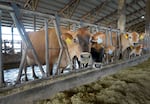
Jersey cows poking their heads out from the feeding stanchion at a Forest Glen Oaks Farm barn in Dayton, Ore.
Alejandro Figueroa / OPB
Even before they decide to build a new barn or milking area, it needs to be approved and then inspected by the Oregon Department of Agriculture, he said.
“All that is set up. All those measures are taken,” Stewart Kircher said.
The lagoon — a large pond where all the water and liquid manure is stored — and the way the barn is built are parts of the compliance requirements for the farm’s Confined Animal Feeding Operation, or CAFO, permit.
Oregon’s CAFO program
In Oregon, there were 493 CAFO permit-holding operations of all sizes as of April 2024, according to Oregon Department of Agriculture data. A CAFO facility might have as few as 15 animals or as many as several thousand, and the permits are not just for dairy farms. The program includes other livestock animals like poultry, hogs, sheep and goats, but the vast majority of permit holders in Oregon are dairy farms.
CAFO operations are spread throughout the state, although Tillamook County has by far the largest concentration with 102. Malheur County in southeast Oregon has 65 CAFOs, and Marion County has 54.
In Oregon, a CAFO does not have to be an agricultural operation. It can even include dog kennels and zoos.
“The dog kennels, they are creating generally quite a bit of liquid waste when they wash out the kennels, spraying things down, and there’s obviously fecal matter in that urine and things like that,” said Isaak Stapleton, the director of the natural resources program area at the Oregon Department of Agriculture.
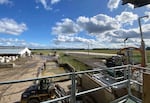
Lagoons at a Forest Glen Oaks production area in Dayton, Ore. Stewart Kircher said the farm usually empties the three lagoons during the warmer growing seasons, when it can apply the liquid manure as fertilizer to its fields.
Alejandro Figueroa / OPB
Stapleton described a CAFO permit as a water quality protection permit that deals with protecting sources of water like rivers, creeks, lakes and groundwater from nutrient pollution caused by animal waste.
“Essentially it comes down to anybody who is confining or holding animals in a prepared barn or surface. Or if somebody has a wastewater treatment system, so if they’re generating liquid waste. Or if they’ve had a discharge,” Stapleton said. “Those are the three ways you become a CAFO.”
Oregon, and most states, are authorized to issue the permit under the U.S. Environmental Protection Agency’s Clean Water Act.
The Oregon Department of Agriculture operates the program under a memorandum of understanding with the Oregon Department of Environmental Quality, although both agencies work together to issue permits. The U.S. EPA also has oversight over the state’s program to ensure the permits meet federal requirements, according to Stapleton.
The permit does not regulate air quality, like methane or ammonia emissions, nor does it address odor concerns some people might have. It also does not regulate land use — although the permit application does require a statement from a local land use authority ensuring a proposed facility is on a site compliant with Oregon’s land-use system.
Oregon CAFO facilities don’t all look the same
Federally, large CAFO facilities are defined as those housing at least 700 dairy cattle, 2,500 pigs or up to 125,000 chickens. But Oregon definitions go further than federal requirements, which is why small livestock farms can also fall under the program, Stapleton said.
Christine Anderson’s farm near McMinnville, Oregon, is one of those smaller farms.
“I don’t think that the image of our farm is what comes up in their mind when we’re talking about a CAFO,” Anderson said.
Her farm has a handful of sheep and goats, some chickens, and three dairy cows. A state policy change in early 2023 had required small raw dairy farms like hers to apply for a CAFO permit.
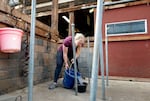
Christine Anderson empties a bucket containing water she used to clean the milking equipment at her milking parlor in McMinnville, Ore., April 18, 2024. Anderson said her CAFO permit prohibits her from dumping it to a drain or her residential septic tank.
Alejandro Figueroa / OPB
To her, it doesn’t make sense to regulate small livestock farms or homesteaders with small numbers of cows, sheep or goats the same way as larger farms because they don’t produce the same amounts of waste as larger livestock operations.
“I’m not in opposition to environmental protection,” Anderson said. “I’m just in opposition to government intervention where it is clearly not necessary.”
The Oregon Department of Agriculture has since reversed the decision requiring CAFO permits for very small farms, although, Anderson said, the agency can still bring back the requirement later on.
How livestock farms manage manure and wastewater
Stapleton, with the state Department of Agriculture, said the basis of a CAFO permit is making sure there’s no pollution to sources of water. That means farmers are not allowed to release animal waste, or discharge, into lakes or rivers, or into groundwater beneath the surface of the land.
“That’s prohibited in all CAFO permits. That’s not happening. That’s not allowed, they cannot discharge anything to surface or groundwater,” Stapleton said.
In many facilities, like larger dairies, that means farm operators collect all the liquid manure in a lagoon that might either be reinforced with a thick plastic liner or sealed with compacted soil and clay.
Some farmers, like the Kircher brothers, separate the solid waste from the liquid.
Stewart Kircher said they usually sell some of the solid manure as fertilizer to local vineyards. He said they also blend manure with plant debris from local seed cleaners to make livestock bedding.
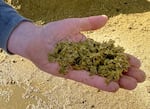
Robert Kircher holds a handful of solid manure which is separated from the liquid waste. He said the farm will use the solid as fertilizer and distribute it to the local vineyards.
Alejandro Figueroa / OPB
At Anderson’s farm, which is small enough that it doesn’t need a lagoon or wastewater tank but still can’t discharge, that means collecting the wash water when she cleans the milking equipment and adding that water residue to a bin of buckwheat and barley. She said she waits until it sprouts, and then feeds it to pigs or sheep.
“We’re nutrient cycling really,” Anderson said. “But it’s just, kind of, recycled water.”
As for the liquid manure, Stapleton said it is considered a beneficial use of nutrients. Through what’s called a Nutrient Management Plan, he said, a producer needs to test the nutrient content of the liquid manure and determine the amount of nutrient a specific crop or field requires before applying it as fertilizer.
Sustainable farm advocates say livestock farms still pollute
Some environmental and sustainable farm advocacy groups say even if a producer follows all the rules, it’s still not enough to protect the bodies of water. Amy van Saun, an attorney based in Oregon for the Center for Food Safety, said CAFO facilities can and do discharge.
“There’s not enough testing to ensure that these fields are actually gonna take up and the crops that are grown, that they’re gonna take up all the nutrients that are sprayed onto them through this waste,” van Saun said.
Van Saun, who’s also a member of a coalition pushing for more CAFO oversight in Oregon, said pollution can occur when rain causes manure lagoons to overflow and spill over to nearby creeks or rivers. They also said rain can wash off manure that’s been applied in fields or groundwater if it’s over applied.
The state Department of Agriculture employs six inspectors to visit each CAFO facility every 10 months to ensure compliance. On average an inspector will visit about 120 farms a year depending on the region they’re in, according to an ODA spokesperson. The spokesperson also said permittees need to self-report if a discharge happens.
But van Saun, along with other advocates, said that just creates a “catch me if you can” system.
“That’s where we find that even though you have a lot of permitting of these facilities and, supposedly, a really high level of compliance with those permits, if they’re not good enough to stop the discharge, and there is no monitoring of whether that discharge is happening, then it kind of doesn’t matter that there’s such a good permitting system,” van Saun said.
Agricultural regulators to bring more oversight
Last year, Gov. Tina Kotek signed Senate Bill 85 into law. The law adds more state oversight, new requirements and definitions for larger CAFO-permitted farms — small and medium-sized facilities are largely unaffected.
Environmental advocacy groups and farmers opposing the bill point to a troubled mega-dairy in Boardman, Oregon, Lost Valley Farm, as one of the main reasons why the state moved to change its CAFO permit rules. In 2018, that farm racked up over 220 wastewater violations and more than $187,000 in fines, according to a report from the Capital Press. The farm eventually ended up shutting down and filing for bankruptcy.
The new law includes changes for new or expanding CAFO operations, such as how large livestock farms can use groundwater. Facilities using more than 12,000 gallons of drinking water from ground sources for their livestock will need to apply for a water permit.
It also lets local governments require setbacks, or buffers, between a proposed facility and its neighbors.
The law also sets stronger requirements for CAFO facilities in groundwater management areas — regions like the Lower Umatilla Basin, where nitrates from agricultural operations have polluted groundwater for decades. That pollution has led to unsafe drinking water for people in the area who rely on wells.
Stapleton said the changes require CAFO-permitted farms in groundwater management areas to install monitoring systems to ensure manure is not seeping below the root zone of crops. He said manure lagoons also need to be double-lined with a synthetic liner to prevent leaking.
Some of Senate Bill 85′s changes will be adopted later this summer, following a set of meetings with farmers and environmental groups and a public comment period, according to Stapleton.
Environmental groups say the changes will further protect communities from pollution.

Stewart Kircher opens a binder detailing how the dairy farms stores and utilizes nutrients from the manure produced by its 2,000 cows.
Alejandro Figueroa / OPB
But Stewart Kircher sees it differently. While sitting in his office at a long table spread with hundreds of pages that detail how the farm complies with state rules, Kircher said the new rules his farm must follow shouldn’t be dictated by a bad actor in the industry.
“The biggest frustration for me is just the image that is being put on us. We’re here producing food, really good quality food, and we get labeled as polluters,” Kircher said. “We’re mindful of the environment, and we kind of just get thrown under the bus.”
He goes on to say he and his brother will stay in business and adapt, but it’ll be while navigating a system they say will make it harder to supply Oregonians with food grown and produced in the state.
“And you look at the finances of a farm right now, not just a dairy but farms in general,” Kircher said. “And then you add on more and more. Is it worth it?”
